Publication
Article
Pharmaceutical Technology
The Effect of Mill Type on Two Dry-Granulated Placebo Formulations
Author(s):
The authors evaluate the effect of various mill types on particle-size distribution, flowability, tabletability, and compactibility.
The particle-size distribution of a pharmaceutical granulation is an important physical characteristic that influences several aspects of a drug (e.g., mechanical properties, content uniformity, compression characteristics, and dissolution performance). Therefore, it is important to control the particle size of the final granulation to ensure drug-product manufacturability and quality. Various mill types currently are available for the size reduction of dry- and wet-granulated pharmaceutical products. To evaluate these milling technologies and their influence on dry-granulated (roller-compacted) formulations, four different mill types were selected for comparison.
Conventional milling is a mechanical process that passes material through a screen or plate to reduce its size into a uniform particle-size distribution. It has been proposed that mill type directly influences particle-size distribution and, consequently, the quality of the final product. However, other variables also influence the milling process. Engineering design differences such as screen size and thickness, impeller and rotor style, and mill-chamber size and shape all affect material-size reduction. Formulations' physical properties determine how well materials maintain their bonds or shear under stress. Operational variation such as impeller and rotor speed and material feed rate may also influence the final particle size.
The ideal pharmaceutical granulation process should provide short residence time in the mill chamber and pass granules quickly through the mill screen while maintaining the integrity of the granule. The strength of the material being milled has an effect on the final granulation particle-size distribution. Hard granules may increase residence time within the milling chamber and produce an excess of large granules in combination with smaller fine particles, thus creating a bimodal particle-size distribution. Minimizing fines in the final granulation enhances the flow properties of the final granulation and improves weight variation during tableting. An ideal particle-size distribution should minimize the level of granules >840 μm (retained on a 20-mesh sieve) and the level of particles <74 μm (passing through a 200-mesh sieve). Most modern mills have variable-speed drives, and are considered low-energy mills when operated at low speeds (i.e., <1000 rpm). Such mills produce granulation within this desired particle-size range and are commonly used within the pharmaceutical industry for granulation-size reduction.
In this experiment, two immediate-release (IR) dry-granulation placebo formulations were selected to evaluate mill performance. Roller-compaction conditions were established using a roller compactor (Mini-Pactor, Gerteis Maschinen + Processengineering, Jona, Switzerland) to produce ribbon at a target solid fraction of 0.7. Ribbon was manufactured from both formulations and characterized for solid fraction, tensile strength, and thickness. Roller-compaction bypass was measured to establish the fines level within the compacted ribbon before milling. Three well established conventional milling options and one unconventional milling operation were compared head-to-head, and the resulting granulation was evaluated for particle-size distribution, flowability, tabletability, and compactibility.
Materials and methods
Mill types. Three established attrition mill types, an oscillating granulator (integrated with the Gerteis roller compactor), a conical mill (Comil model 197, Quadro Engineering, Waterloo, ON, Canada), and a hammer mill (FitzMill model M5A, Fitzpatrick, Elmhurst, IL), were selected to compare size-reduction performance. In addition, the authors selected a less conventional nonattrition roller mill (Gran-U-Lizer, Modern Process Equipment [MPE], Chicago) to be evaluated.
Oscillating granulator (mill integrated with roller compactor). The principle of an oscillating granulator is to mechanically pass compacted material through a wire mesh screen or plate using an oscillating rotor. The rotor speed and rotation time are variable in the clockwise or counterclockwise directions. Particle size is controlled through mill-screen size, rotor speed, and the rotor's rotation angle (1).
Conical mill. The conical mill is an attrition-type mill and performs size reduction using a rotating wedge-shaped impeller inside a conical screen. Particle size can be changed using interchangeable screens and impeller styles. The impeller selected for this study was a high-throughput, round, leading-edge impeller, and particle-size reduction was controlled with screen size and impeller speed (1).
Comminutor hammer mill. Comminutor hammer mills are also considered attrition-style mills and reduce the particle size with several rotating hammers or knives or a rotor bar. The blade type, speed, and screen size are the important variables that influence the milling process (1). The rotor bar was used for this study, and particle size was controlled by screen size and rotor speed.
Gran-U-Lizer. The Gran-U-Lizer is a nonattrition size-reduction mill. It uses roller-mill technology that contols particle-size reduction through roll-surface texture (i.e., roll type), roll speed, and roll gap. According to MPE, the Gran-U-Lizer operates through the use of shear, in contrast to impact used by conventional size-reduction equipment. The Gran-U-Lizer achieves a narrower particle-size distribution with fewer fines by eliminating the attrition inherent in other milling designs. The laboratory model Gran-U-Lizer requires several passes through the rolls using various roll types, roll speeds, and roll gaps to achieve the desired particle-size distribution. All milling trials using the Gran-U-Lizer roller mill were conducted at MPE's Chicago site.
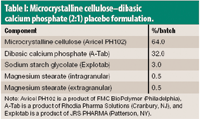
Table I: Microcrystalline celluloseâdibasic calcium phosphate (2:1) placebo formulation.
Formulation
Two IR, dry-granulation placebo formulations (see Tables I and II) were selected to evaluate mill performance. Roller-compaction conditions were established using the Gerteis Mini-Pactor roller compactor to produce ribbon at a target solid fraction of 0.7 at an approximate thickness of 2.5 mm. Ribbon was manufactured from both formulations and characterized for solid fraction, tensile strength, and thickness. Roller-compaction bypass was measured to establish the fines level within the compacted ribbon before milling.
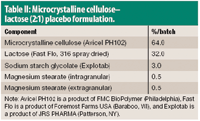
Table II: Microcrystalline celluloseâlactose (2:1) placebo formulation.
Ribbon characterization
Solid fraction. Ribbon samples were prepared by cutting the compacted ribbon into rectangular shapes of approximately 10 x 22 mm using a jeweler's table saw. Figure 1 demonstrates how the ribbon sample was prepared. The cut ribbon sample was measured using calipers to determine the envelope density.
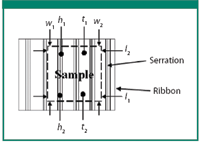
Figure 1: Measurements of ribbon dimensions. (AUTHORS)
The solid fraction of each ribbon sample was determined according to a relationship that can be expressed by the following equation:

in which w is the ribbon width, l is the ribbon length, t is the ribbon thickness, m is the ribbon mass, Vs is the volume of the roller serrations, and ρt is the true density of the material.
Tensile strength. The ribbon's tensile strength was determined using a three-point beam-bending tester (CT-5, Holland Instruments, Nottingham, UK). Each ribbon sample was placed onto the two beams, separated by a known distance L. A force F was applied in the middle of the sample until the sample failed. Figure 2 demonstrates this test.
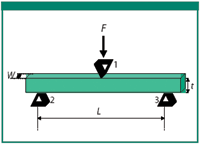
Figure 2: Three-point beam bending test arrangement. (AUTHORS)
The tensile strength of the compact can be determined from the following relationship:

in which σT is fracture tensile strength, F is the load applied at fracture, W is the width of sample, L is the distance between beams 2 and 3, and t is the thickness of the sample.
Experimental plan
Dry granulation by means of roller compaction. Ribbon from each formulation was roller compacted to an equivalent target solid fraction, tensile strength, and thickness using the Gerteis Mini-Pactor. The ribbon was collected in approximately 1.0-kg portions throughout each compaction run to ensure that the level of bypass remained consistent for each milling trial. It was important to the integrity of this study that the ribbon not be collected in one large portion and that ribbon not be subdivided from one main ribbon supply because this could potentially cause segregation of bypass (fines) during ribbon storage and produce inconsistent milling results. Also, it was equally important that the bags of ribbon be numbered sequentially to easily identify at what time in the roller compaction process a particular bag was compacted. The ribbon's physical properties were characterized from each 1.0-kg portion collected to determine the consistency of the ribbon produced. Figure 3 illustrates the experimental plan used to produce ribbon for milling.
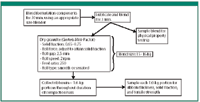
Figure 3: Roller-compaction experimental plan. (AUTHORS)
Milling and tableting. The milling conditions selected for the Gerteis and M5A mill were based on previously established milling parameters used for the size reduction of roller-compacted ribbon. The 0.8-mm screen size selected for both mill types produces satisfactory granules for conventional IR tablet formulations consistently. The Comil speed was calculated to achieve a tip-speed equivalent to that of the M5A mill equipped with a rotor bar. The larger mill screen size used for the Comil was based solely on availability. The G040 (~1.0-mm) screen was the smallest rasping-style screen size available at that time from Quadro for the 197 Comil. The differences in screen size between the Gerteis OG, M5A, and Comil are considered to have minimal effect on the final particle-size distribution, given the considerable difference in mill designs. The Gran-U-Lizer milling conditions (e.g., number of passes through the rolls, roller type, roller speed, and roller-speed ratio) were determined during a series of milling trials conducted by MPE's engineering staff. Figure 4 illustrates the milling conditions used for each milling operation.
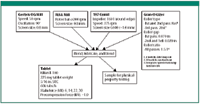
Figure 4: Milling and tableting experimental plan. (AUTHORS)
Tableting was performed using a rotary tablet press (T-100, Kilian) at a press speed of 60,000 tablets/h to produce a dwell time of ~11 ms, which approaches a production-press speed dwell time of <10 ms. A precompression force of approximately 1 kN was used for all compression runs. The tooling size was selected based on the target tablet weight of 225 mg (5/16-in. standard round concave tooling typically accommodates a fill weight of 200–250 mg). A compression profile was generated for each granulation up to approximately 80% (30 kN) of the maximum allowable force (37 kN) for the tooling size.
Roller compaction
Compaction parameters. Ribbon solid fraction is considered to be the physical attribute with the greatest influence on the physical properties of a dry granulation. The typical compacted ribbon solid fraction range for a conventional IR tablet formulation is 0.6–0.8 (2, 3). Therefore, a target solid fraction of 0.7 was selected to evaluate mill performance. Solid fraction, or relative density, is the measure of the ribbon's apparent density (sample volume in cubic centimeters divided by its mass in grams) divided by the material's true (i.e., absolute) density.
Previous experience with the Gerteis roller compactor influenced the process parameters selected for ribbon compaction except the roll type and roll force. A ribbon thickness >1.0 mm was unobtainable for the microcrystalline cellulose (MCC)–dibasic calcium phosphate (DCP) formulation using smooth rolls. However, the target ribbon thickness of 2.5 mm was obtainable when serrated rolls were used. Therefore, serrated rolls were used to compact both formulations.
A series of compaction trials were performed for both formulations to determine the roll force required to achieve the target ribbon solid fraction. A roll force of 8 kN/cm2 was selected as the best roll force for the MCC–DCP formulation, and a roll force of 6 kN/cm2 was selected for the MCC–lactose formulation. Although two different roll forces were used, both formulations were compacted using a roll gap of 2.5 mm, a roll speed of 2.0 rpm, and a feed ratio of 250 to produce ribbon at the target solid fraction of 0.7.
Results and discussion
Ribbon properties. Three ribbon samples were collected from each formulation and characterized for solid fraction, tensile strength, and thickness for each ribbon portion collected (~1.0 kg) during the compaction run. A total of 11 sample points were collected for the MCC–DCP formulation, and 13 sample points were collected for the MCC–lactose formulation, corresponding to process times of 84 min and 113 min, respectively. Table III lists the ribbon bag number and corresponding measured solid fraction, tensile strength, and thickness values for each 1.0-kg portion collected.
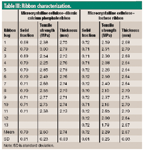
Table III: Ribbon characterization.
Ribbon bypass level. Because the level of bypass generated during the compaction process influences the fines level in the milled granulation, it was relevant to measure the bypass level before ribbon milling. Bypass is defined as uncompacted primary particles of active pharmaceutical ingredient or excipients that migrate around the rolls without being subjected to any compaction force.
The dry-granulation bypass level was measured by removing the bulk of the ribbon from the compacted material by hand and sieving the remaining material through a 100-mesh (150-μm) sieve. The material that passed through the 100-mesh sieve is mainly uncompacted primary particles and is considered bypass. Using this method, the amount of bypass measured for the MCC–DCP formulation was 2.4% (ribbon bag #10). The amount of bypass measured for for the MCC–lactose formulation was 2.1% (ribbon bag #10).
Milling. Both formulations were milled using the 1.0-kg bags of ribbon collected during the roller-compaction process. Because individual bags of ribbon were used and the bypass level was well controlled, it can be assumed that any difference in the postmilling fines level was generated by the milling process and not a result of segregation during handling of the ribbon. Also, because the ribbon sample bags were numbered during roller compaction, the results of each milling trial can be directly compared with ribbon solid fraction, tensile strength, and thickness values. One milling for each formulation was performed using each of the mill types.

Table IV: Microcrystalline celluloseâdibasic calcium phosphate granulation particle-size (μm) and flow properties.
One major difference between the conventional mill types and the Gran-U-Lizer was the number of passes necessary to achieve the desired particle-size distribution. The conventional mill type required only one pass to achieve the desired reduction in particle size. The Gran-U-Lizer required several passes using different roller styles, roller speeds, and roller gaps. According to MPE, multiple passes produce a gradual reduction in particle size and thus a low level of fines.

Table V: Microcrystalline celluloseâlactose granulation particle size (μm) and flow properties.
Granule physical property data. Particle-size distribution. Tables IV and V show the results of laser-diffraction particle-size analysis using a disperser (HELOS/RODOS, Sympatec, Clausthal-Zellerfeld, Germany). The particle-size distributions show that the Gran-U-Lizer produced the largest particle size of all the mills tested. However, all the milled formulations had similar distributions, as demonstrated in Figures 5 and 6. In addition, the distributions for both formulations were broad, regardless of the mill type used.
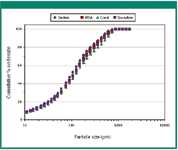
Figure 5: Microcrystalline celluloseâdibasic calcium phosphate placebo particle-size distribution. (AUTHORS)
Flowability. The MCC–DCP formulation exhibits excellent flowability across all mill types, while the MCC–lactose formulation exhibits lower (good) flowability, with the exception of the Gran-U-Lizer, which demonstrated excellent flow based on a flow function coefficient value of 10.1 (4). However, the larger particle size of the Gran-U-Lizer granulations did not substantially improve the flowability of either formulation.
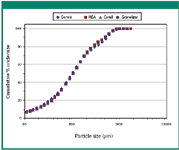
Figure 6: Microcrystalline celluloseâlactose placebo particle-size distribution. (AUTHORS)
Tableting. MCC–DCP formulation. Tablets were compressed and characterized for weight, thickness, and hardness. The mean weight values and corresponding relative standard deviations (RSDs) are listed in Table VI. Weight variation was below the desired RSD of 2.0% for all the conventional mill types. The two Gran-U-Lizer runs had slightly higher RSDs, but they were still below the 6.0% RSD allowed by US Pharmacopeia criteria.
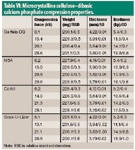
Table VI: Microcrystalline celluloseâdibasic calcium phosphate compression properties.
The tabletability profile (see Figure 7) shows that the tensile strength of all the tablet lots easily exceeded the desirable target crushing strength of 2.0 MPa. Also, the compactibility profile (see Figure 8) shows that the tablets achieved a tensile strength of 2.0 MPa at a solid fraction of approximately 0.80–0.81, indicating that strong bonds were formed at relatively low solid fractions. All formulations performed well, regardless of the mill type used or difference in particle-size distribution.
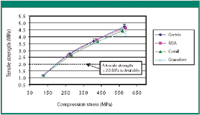
Figure 7: Tabletability profile for microcrystalline celluloseâdibasic calcium phosphate formulation. (AUTHORS)
MCC–lactose formulation. Weight variation for all the mill types was well below an RSD of 2.0%, and weight control is not considered a problem, regardless of the difference in particle-size distribution. Weight, thickness, and hardness values are listed in Table VII.
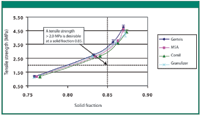
Figure 8: Compactibility profile for microcrystalline celluloseâdibasic calcium phosphate formulation. (AUTHORS)
The tabletability plot (see Figure 9) shows that the tensile strength of all the lots easily exceeded the desirable target of 2.0 MPa. However, the Gerteis milled formulation performed the best of all the lots. Its maximum tablet-crushing strength was ~0.5 MPa higher than the other mill types. The compactibility profile (see Figure 10) shows that the tablets achieved a tensile strength of 2.0 MPa when compaction was at a solid fraction of approximately 0.86–0.88. All formulations performed similarly, regardless of the mill type used and the difference in particle-size distribution, except for the Gerteis milled granulation.
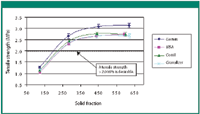
Figure 9: Tabletability profile for microcrystalline celluloseâlactose formulation. (AUTHORS)
Conclusions
In general, the mill type used and resulting granulation particle-size distribution did not greatly influence the tabletability or compactibility of either placebo formulation. The MCC–DCP formulation demonstrated excellent tableting and compaction properties, regardless of the mill type used. Although a higher RSD for the tablet weight values using the Gran-U-Lizer was observed, it is considered acceptable. Adjustments to the Gran-U-Lizer parameters might make the particle-size distribution slightly lower and improve the granulation, tableting, and compaction performance.

Figure 10: Compactibility profile for microcrystalline celluloseâlactose formulation. (AUTHORS)
The MCC–lactose formulations produced tablets of a lower crushing strength than those of the MCC–DCP formulations for all the mills evaluated. Although all the granulations performed similarly, some differences in tabletability and compactibility were evident. One noteworthy difference was a higher tablet-crushing strength for the Gerteis-milled material. Tablets had an approximately 0.5 MPa higher strength compared with the other milled lots. The authors found no definitive explanation for these results.
Although all the granulations have a flowability rating of good, the Gerteis granulation had the lowest value of 8.0, compared with the 9.1 and 9.0 for the M5A and Comill, respectively. The lower flowability value suggests a higher level of smaller particles in the granulation and correlates with the laser-diffraction data showing the Gerteis material having the smallest D10 and D50 particle-size values. However, the Gerteis material also has the highest D90 value and the greatest breadth of particle size for the three granulations. The smaller particle size and greater breadth of this granulation may contribute to the higher tabletability and compactibility observed. Also, the difference in particle size could be attributed to the ribbon properties.
Review of the ribbon characterization for the individual bags collected (see Table III, bag #5, 6, 7) during roller compaction suggests that the ribbons used for the three conventional mill types have identical solid fraction and thickness. The ribbon tensile strength used for the Gerteis milling, however, was the lowest of the three. It is possible that the lower strength of the ribbon contributed to the difference in granulation-particle size, thus leading to a difference in bonding properties and tablet-crushing strength.
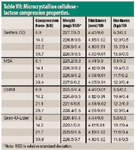
Table VII: Microcrystalline celluloseâlactose compression properties.
Overall, formulation composition, not mill type, had the most significant effect on compaction properties. Compression using a high-speed rotary tablet press confirmed that differences in the formulation composition had an effect on tabletability and compactibility and that mill type did not significantly influence the tabletability and compactibility of the formulations.
Acknowledgments
The authors acknowledge Barbara Spong's active support of this study.
Thomas A. Vendola* is a scientist in solids development, and Bruno C. Hancock is a research fellow in material sciences at Pfizer, Eastern Point Rd., Groton, CT 06340, tel. 860.441.4430, fax 860.441.3972, thomas.a.vendola@pfizer.com
*To whom all correspondence should be addressed.
Submitted: Jan. 28, 2008. Accepted: Mar. 20, 2008.
What would you do differently? Email your thoughts about this paper to ptweb@advanstar.com and we may post them to the site.

References
1. R.J. Lantz, "Size Reduction," in Pharmaceutical Dosage Forms: Tablets, H.A. Lieberman, L. Lachman, and J.B. Schwartz, Eds. (Marcel Dekker, New York, Vol. 2, 2nd ed., 1990), pp. 107–200.
2. B.C. Hancock et al., "The Relative Densities of Pharmaceutical Powders, Blends, Dry Granulations, and Immediate-Release Tablets," Pharm. Technol. 27 (4), 64–80 (2003).
3. A.V. Zinchuck, M.P. Mullarney, and B.C. Hancock, "Simulation of Roller Compaction Using a Laboratory Scale Compaction Simulator," Int. J. Pharm. 269, 403–415 (2004)
4. S. Behera et al., "Flowability Studies of Bulk Materials for Design of Hopper Using a Jenike Shear Cell," Powder Handling and Processing 14, 96–101 (2002)
Newsletter
Get the essential updates shaping the future of pharma manufacturing and compliance—subscribe today to Pharmaceutical Technology and never miss a breakthrough.






